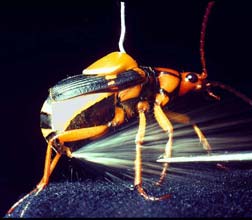Beetles could prove a hit with the aircraft industry

The bombardier beetle in action<br><br>Credit: Thomas Eisner and Daniel Aneshansley, Cornell University
The bombardier beetle’s unique natural combustion technique is being studied to see if it can be copied for use in the aircraft industry.
Scientists studying the bombardier beetle’s jet-based defence mechanism hope it will help to solve a problem that can occasionally occur at high altitude – re-igniting a gas turbine aircraft engine which has cut out, when the outside air temperature is as low as minus 50 degrees Centigrade!
Due to start early next year, this innovative 3-year project at the University of Leeds is being funded by the Engineering and Physical Sciences Research Council (EPSRC).
The bombardier beetle defends itself by squirting predators (ants, frogs, spiders) with a high-pressure jet of boiling liquid in a rapid-fire action called pulse combustion. Building on work by Professor Tom Eisner at Cornell University, the new project will set out to improve understanding of the beetle’s unique pulse combustion and nozzle ejection mechanism. It also aims to identify how combustion engineers could exploit this understanding to practical effect. For example, knowledge gained could aid the development of a device that helps relight aircraft engines at high altitude by squirting plasma into the engine’s combustion chamber more accurately.
The project will involve computer-based numerical and mathematical modelling. Initially it will focus on understanding the beetle’s heart-shaped miniature combustion chamber, which is less than 1 millimetre long. Simulations for a larger chamber around a few centimetres long will then be conducted, in which gases are ignited by raising the chamber’s surface temperature. The effect of different shaped nozzle outlets and explosion chambers will also be examined.
The project team will be led by Andy McIntosh, Professor of Thermodynamics and Combustion Theory at the Energy and Resources Research Institute in the University of Leeds. Professor McIntosh says: “The bombardier beetle’s defence mechanism represents a very effective natural form of combustion. Copying such natural mechanisms is part of the growing field of biomimetics where scientists learn much from intricate design features already in nature. Understanding this beetle better could lead to significant advances in combustion research.”
Media Contact
More Information:
http://www.epsrc.ac.uk/All latest news from the category: Process Engineering
This special field revolves around processes for modifying material properties (milling, cooling), composition (filtration, distillation) and type (oxidation, hydration).
Valuable information is available on a broad range of technologies including material separation, laser processes, measuring techniques and robot engineering in addition to testing methods and coating and materials analysis processes.
Newest articles

Silicon Carbide Innovation Alliance to drive industrial-scale semiconductor work
Known for its ability to withstand extreme environments and high voltages, silicon carbide (SiC) is a semiconducting material made up of silicon and carbon atoms arranged into crystals that is…

New SPECT/CT technique shows impressive biomarker identification
…offers increased access for prostate cancer patients. A novel SPECT/CT acquisition method can accurately detect radiopharmaceutical biodistribution in a convenient manner for prostate cancer patients, opening the door for more…

How 3D printers can give robots a soft touch
Soft skin coverings and touch sensors have emerged as a promising feature for robots that are both safer and more intuitive for human interaction, but they are expensive and difficult…





















